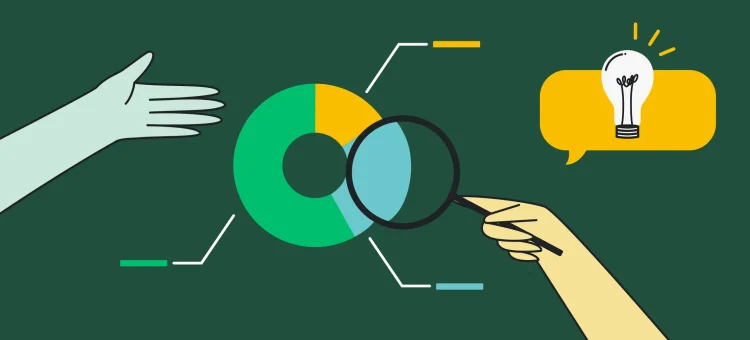Key Findings
- Is education the great equalizer? Majority of adults with student loans say it’s not worth it, given delays in milestones and difficult financial situations.
- Nearly 6 in 10 Americans say President Biden should make student loan forgiveness a priority, with a large majority supporting forgiveness for some.
- Adults with federal student debt reflect populations that lack historical access to capital.
- Adults with student loans are well informed on the status of their loans.
- During the student loan pause, quality of life largely remains the same as loaners try to keep up with the increasing cost of living.
Majority of adults with student loans say it was not worth it, given delays in milestones and difficult financial situation
Nearly all people with student loans (81%) say they've had to delay key life milestones, such as saving for retirement or buying a home, in order to pay off their student loans. Nearly half of those under 35 say student loans have delayed them buying a home (44%) and investing their money (44%). Adults age 35-64 say student loans delay them in paying off other loans (46%) and saving for retirement (42%). White adults say paying student loans will delay saving for retirement (45%) and investing money (45%), while Black adults will delay paying off other loans (50%) and buying a home (35%). Overall:
- 42% delay paying off other loans
- 40% delay investing money
- 38% delay saving for retirement
- 35% delay travel
- 33% delay buying a home
- 16% delay having a baby
- 14% delay getting married
- 12% delay finding a new job
A majority (54%) of adults with student loans say it was not worth it to take on debt. Those who took on more student loans are more likely to say it was worth it.
- Those with student debt (33%) were slightly more likely than those without federal student debt (28%) to say their financial situation has worsened over the past two years.
- Adults with no federal student debt are twice as likely (16%) to describe their household finances as excellent compared with those who have student loan debt (8%).
- Gen Zers are most likely to say it was worth it of all age groups (52% of Gen Z, 41% of Millennials, 44% of Gen X, 44% of Boomers).
- A majority of those who completed a four-year degree (57%) or a Masters/PhD (55%) say their degree was worth it, compared to 36% of those who did not finish their degree.
- 6 in 10 (61%) of those who make below $50,000 say it was not worth it (52% of those who make $50,000-$99,999 and 41% of those who make above $100,000).
6 in 10 (62%) U.S. adults with federal student loans say their debt negatively affects their mental health. The less an individual earns, the more likely their mental health suffers, as 7 in 10 (70%) of those who make less than $50,000 say their student loans negatively affect their mental health (59% of those who make between $50,000 and $99,999, 47% of those who make more than $100,000).
- More women (65%) than men (54%) say student debt negatively affects their mental health.
- Boomers are least likely to say their loans negatively affect their mental health (62% of Gen Z, 62% of Millenials, 63% of Gen Xers, and 55% of Boomers.
Half of Americans say President Biden should make student loan forgiveness a priority, with large majority supporting forgiveness
Most adults in the U.S. (57%) want President Biden to make student loan forgiveness a priority. This majority increases by 27 points to 84% when considering just those with federal student loans.
- 4 in 10 are paying attention to the pause on student loan payment: 71% of those with loans say they have been following the student loan pause closely–38% of those say very closely.
- Overall, nearly two-thirds (62%) of adults in the U.S. say they approve of President Biden’s decision to pause student loan repayment until May 1st, which grows to 84% approval among federal student loan borrowers.
- The general public is split on what will happen next: 29% say student loan payments will resume on May 1st, 26% say student loan repayment will be paused again, 28% say some individuals’ student loans will be forgiven, and 14% say all student loans will be forgiven.
Overall, seven in 10 people (69%) say President Biden should grant some type of student loan forgiveness: one-third (34%) of the general public says all student loans should be forgiven, one-third (35%) says that student loans should be forgiven for just those in need, and 1 in 4 (27%) say no student loans should be forgiven for anyone.
- 1 in 5 Republicans (19%) say all student loans should be forgiven, which is significantly less likely than Independents (43%) or Democrats (46%) who say the same.
- Women (38%) are more likely to support student loan forgiveness for all than men (29%).
- More than half (52%) of Black adults support canceling student loans for all, followed by 42% of Hispanics, 29% of whites, and 27% of Asians.
- More than half (53%) of Black women say student loans should be forgiven for all (50% of Black men, 40% of Hispanic women, 33% of Hispanic men, 34% of white women, 24% of white men).
- Gen Zers are most supportive of forgiving all student loans (45% of Gen Z, 43% of Millennials, 32% of Gen X, 23% of Boomers).
- Those who make less than $50,000 are most likely to say all student loans should be forgiven (42% of those who make $50,000, 33% of those who earn $50,000-$99,999, 25% of those who make more than $100,000).
- Those who owe more than $100,000 are most supportive of forgiving loans for everyone (76% of those who owe $100,000+, 65% of those who owe $50,000-$100,000, 65% of those who owe $25,000-$50,000, 67% of those who owe $10,000-$24,999, 59% of those who owe less than $10,000).
Adults with federal student debt are younger and more likely to be people of color and women
Two-thirds (68%) of U.S. adults have debt:
- 35% have credit card debt.
- 35% have a car loan.
- 32% have a mortgage loan.
- 15% have federal student loan debt.
- 12% have medical debt.
- 6% have private student loan debt.
Reflecting historical access to capital, more people of color and women have federal student loan debt.
- 1 in 4 (24%) Black adults say they have federal student loan debt (14% of whites, 15% of Hispanics, 11% of Asians).
- Women (19%) are more likely than men (11%) to have student loan debt. This is true among all races, with Black and Hispanic women being twice as likely as their male counterparts to have student loan debt (11% of white men, 17% of white women, 15% of Black men, 31% of Black women, 10% of Hispanic men, 19% of Hispanic women).
- 1 in 4 (23%) Millennials have student loan debt (18% of Gen Z, 17% of Gen X, 7% of Boomers). Young women age 18-44 are by far most likely to have federal student loan debt (15% of men age 18-44, 8% of men age 45+, 27% of women age 18-44, 13% of women age 45+).
- 1 in 5 (20%) Democrats have federal student loan debt (13% of Independents, 12% of Republicans).
Adults with student loans are well informed on the status of their loans
Adults with student loans are well informed on the status of their student loans.
- Nearly all (80%) of adults with student debt know who their servicer is.
- Those who do not know their servicer are more likely to have not finished their college degree.
- 1 in 4 (25%) of those who make less than $50,000 do not know their servicer (15% of those who make $50,000-$99,999, 6% of those who make more than $100,000).
- One third (37%) of those with student debt do not know their interest rate.
- 1 in 4 (26%) of student loan debtors say their servicer has changed in the past two years (52% say it has not changed, 21% are not sure).
- Nearly half (42%) of adults with student loans receive communications from their servicer once a month, 19% hear from them every 6 months, 10% receive communications once a year, 10% hear from their service at least once a week, and 18% do not receive communications at all.
The majority (55%) of adults with federal student loans owe less than $25,000 (21% owe between $25,000 and $50,000, 15% owe between $50,000 and $100,000, 8% owe more than $100,000).
- Those who make more than $100,000 are more likely to have more than $100,000 in loans (17% of those who make more than $100,000, 7% of those who make $50,000-$99,999, and 5% of those who make less than $50,000).
- Two-thirds (64%) of individuals who owe more than $100,000 have a Masters or PhD (25% have a 4 year degree, 5% did not/have not finished college).
- Nontraditional students (age 25+ who have not finished college) are more likely to take out more loans than traditional college students.
Nearly 6 in 10 (57%) adults with student loans do not participate in any student loan repayment plans, 3 in 10 (30%) participate in an income-driven repayment plan, 7% participate in Public-Service Loan Repayment, and 3% participate in employer-funded loan assistance.
Individuals with federal student loan debt often have other loans to worry about as well.
- 53% have credit card debt, compared to 33% of those with no federal student loans.
- 47% say they have a car loan, compared to 35% of those with no federal student loans.
- 31% have a mortgage loan, compared to 34% of those with no federal student loans.
- 24% have private student loans, compared to 3% of those with no federal student loan debt.
- 24% have medical debt, compared to 10% of those with no federal student loans.
During the student loan pause, quality of life largely remains the same as loaners try to keep up with the increasing cost of living
During the pause on federal student loan payments, two-thirds (67%) of loaners did not make a payment, 19% continued their monthly payments, and 13% made less frequent payments.
- Those who continued making monthly payments are more likely to be male, Boomers, Republicans and make more than $100,000.
- 4 in 10 (40%) of debtors who say their quality of life remained the same during the student loan pause continued to pay their student loans, either monthly or less frequently.
Rather than avocado toast, those who did not pay their student loans during the pause used the money towards everyday expenses (48%), paid off other debts (35%), or saved it (14%).
- Women, millennials, and those who make less than $50,000 were more likely to use the money they saved on everyday expenses.
- Those with higher incomes used the money they saved to pay off other debts.
Instead of increasing spending (18%), the large majority of debtors either decreased their spending (14%) or did not change their spending habits (66%). Individuals who increased their spending say they spent more money trying to keep up with the increasing cost of everyday items, like food, clothing, car maintenance, and supplies for school.
Overall, 4 in 10 (39%) say the pause improved their quality of life (55% say it remained the way, and 4% say it worsened). Women, Gen Z, those who owe more than $100,000, and whites are most likely to say the pause on student loans improved their quality of life.
Read more about our polling methodology here.
Click through all the results in the interactive toplines below:



